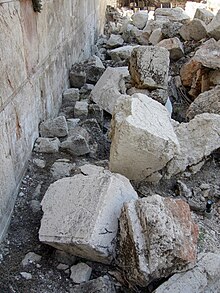|
Matthew 24
Matthew 24 is the twenty-fourth chapter of the Gospel of Matthew in the New Testament of the Christian Bible. It commences the Olivet Discourse or "Little Apocalypse" spoken by Jesus Christ, also described as the Eschatological Discourse,[1] which continues into chapter 25.[2] It contains Jesus' prediction of the destruction of the Temple in Jerusalem.[3] Mark 13 and Luke 21 also cover the same material.[4] TextThe original text was written in Koine Greek. This chapter is divided into 51 verses. Textual witnessesSome early manuscripts containing the text of this chapter are:
Old Testament referencesContextIn the preceding chapters (chapters 21–23), Jesus has been teaching in the Temple and debating with the Pharisees, Herodians and Sadducees. Jesus and his disciples now leave the Temple (Matthew 24:1), or the temple grounds in the New Living Translation.[5] Theologian John Gill observes that Jesus was "never to return".[6] Arthur Carr reports that in descending the Kedron Valley, to the east of the temple, and then ascending the slope of the Mount of Olives, the disciples could look back and see "the Temple [rising] with its colonnade of dazzling white marble, surmounted with golden roof and pinnacles, and founded on a substructure of huge stones".[2] Verses 1-2 In this "introductory scene",[7]: 876 Jesus predicts that "not one stone shall be left here upon another".[8] The prediction follows the sentiments expressed by Jesus in Matthew 23:37–38:
Methodism's founder John Wesley says that the prediction was "most punctually fulfilled" in that the majority of the temple buildings were burned and then dug up on the orders of the invading Roman general Titus in 70 AD.[9] Mount of OlivesJesus and his disciples then proceed to the Mount of Olives, where a conversation occurs about "the end of the age". Jesus's words here called the "Little Apocalypse" or "Olivet Discourse". Jesus appears to have gone ahead of his disciples (Matthew 24:3), who come to him to enquire about the time of the temple's destruction (Tell us, when will these things be?, verse 3) and the significance of his parousia (Greek: παρουσιας, parousias). Mark 13:3 states that only Peter, James, John, and Andrew came to speak with him.[2] Dale Allison divides Jesus' warnings into three groups:
Verse 5
This verse reads 'I am Christ', lacking the definite article, in the Geneva Bible (1599),[11] the King James Version,[12] and the New Matthew Bible [13] (a modernised version of the New Testament of William Tyndale).[14] Carr (1882 onwards) observes that "the Christ, the Messiah" is correct, departing from the King James Version then in use.[2] Verse 9
This foretelling of Christian suffering is concerned with making it bearable.[7]: 876 Verse 15
The "abomination of desolation" is alternatively described as the "desolating sacrifice" in the New Revised Standard Version.[17] Citation from Daniel 11:31; Daniel 12:11 Verse 20
The hardship associated with escape during winter is likely to arise from bad weather.[19] Allison notes the absence of any explanation as to why flight on a sabbath day might also be more challenging; he suggests that Matthew's community might still have observed the sabbath as a day of rest, with its traditional travel restrictions, and been both hesitant and unprepared for flight on such a day.[7]: 877 Verses 29-31
In the Bahá'í Faith, Bahá'u'lláh gives an interpretation of Matthew 24:29-31 in his major theological work Kitáb-i-Íqán (The Book of Certitude),[21][22] giving detailed explanations about the allegorical meanings of each of these phrases.[23] Verse 35
Jesus's words refer to an Old Testament saying recorded in Isaiah 51:6:
See also
References
External links
|
||||||||||||||
